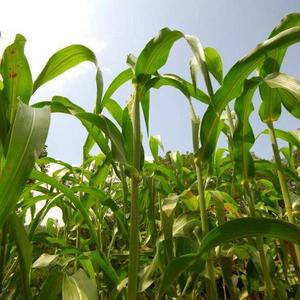USDA predicts another record corn crop

May 12, 2014
BY Erin Krueger
In its May 9 World Agricultural Supply and Demand Estimates report, the USDA predicted that U.S. farmers are on track to produce another record corn crop. According to the WASDE report, corn production is expected to reach 13.9 billion bushels this year, up slightly from the 2013/2014 record with higher expected yields more than offsetting the year-to-year reduction in planted area. The report forecasts corn yields will be 165.3 bushels per acre, up 6.5 bushels from 2013/14, based on a weather-adjusted yield trend model and assuming normal mid-May planting progress and summer weather. Corn supplies for 2014/15 are expected to be at a record 15.1 billion bushels, up 330 million from 2013/14.
U.S. corn use for 2014/15 is projected 2 percent lower than in 2013/14. Corn used to produce ethanol in 2014/15 is expected to be unchanged on the year with gasoline consumption expected to remain flat in 2015. Feed and residual use is projected 50 million bushels lower with animal numbers down from 2013/14. Exports are projected 200 million bushels lower than this month’s higher projection for 2013/14 as larger expected foreign supplies and lower import demand limit U.S. shipments. Corn ending stocks are projected at 17.1 billion bushels, up 580 million from the 2013/14 projection. With the larger carryout, the season average farm price is projected at $3.85 to $4.55 per bushel, down from $4.50 to $4.80 per bushel for 2013/14.
Advertisement
World corn consumption is projected at a record 965.8 million tons, up 17 million from 2013/14 on higher use in China, Brazil, the European Union, Mexico and Japan. Global corn ending stocks for 2014/15 are projected at 181.7 million tons, up 13.3 million tons on the year and a 15-year high.
In a response to the WASDE report, the National Corn Growers Association noted that if the USDA’s forecast is realized, U.S. farmers will produce a record corn for the second year in a row. “America’s corn farmers continuously strive to improve and, in 2014, they certainly will make their achievements evident should these projections be realized,” said National Corn Growers Association Chairwoman Pam Johnson. “As farmers, we take great pride in our work and feel that the projections recognize our efforts. Yet, our optimism is tinged caution as we have all seen conditions change quickly and a crop shift course in a few short weeks. We remain diligent in our work, striving to produce that abundance for a world with constantly increasing food, feed and fuel needs.”
University of Iowa economist Darrel Good addressed the May WASDE forecast in a May 12 FarmDocDaily post. Regarding ethanol, Good noted that the projected amount of corn used for ethanol production was increased by 50 million bushels compared to the April report, reaching a total of 5.05 billion bushels. “That projection is consistent with the magnitude of ethanol production from September 213 through April 2014 and the current weekly pace of production and came as no surprise,” he wrote.
Advertisement
Good also addressed the USDA’s price predictions. “Although other actors may have contributed, corn prices declined following the release of the new projections. Given the surprisingly large level of consumption of U.S. corn that has unfolded this year and planting season weather that may pose a threat to both planted acreage and yield in some areas, the price weakness appears to be premature,” he wrote.
Related Stories
U.S. fuel ethanol capacity fell slightly in April, while biodiesel and renewable diesel capacity held steady, according to data released by the U.S. EIA on June 30. Feedstock consumption was down when compared to the previous month.
The U.S. EPA on July 8 hosted virtual public hearing to gather input on the agency’s recently released proposed rule to set 2026 and 2027 RFS RVOs. Members of the biofuel industry were among those to offer testimony during the event.
The USDA’s Risk Management Agency is implementing multiple changes to the Camelina pilot insurance program for the 2026 and succeeding crop years. The changes will expand coverage options and provide greater flexibility for producers.
The USDA’s National Agricultural Statistics Service on June 30 released its annual Acreage report, estimating that 83.4 million acres of soybeans have been planted in the U.S. this year, down 4% when compared to 2024.
SAF Magazine and the Commercial Aviation Alternative Fuels Initiative announced the preliminary agenda for the North American SAF Conference and Expo, being held Sept. 22-24 at the Minneapolis Convention Center in Minneapolis, Minnesota.
Upcoming Events










